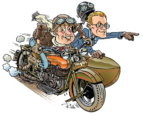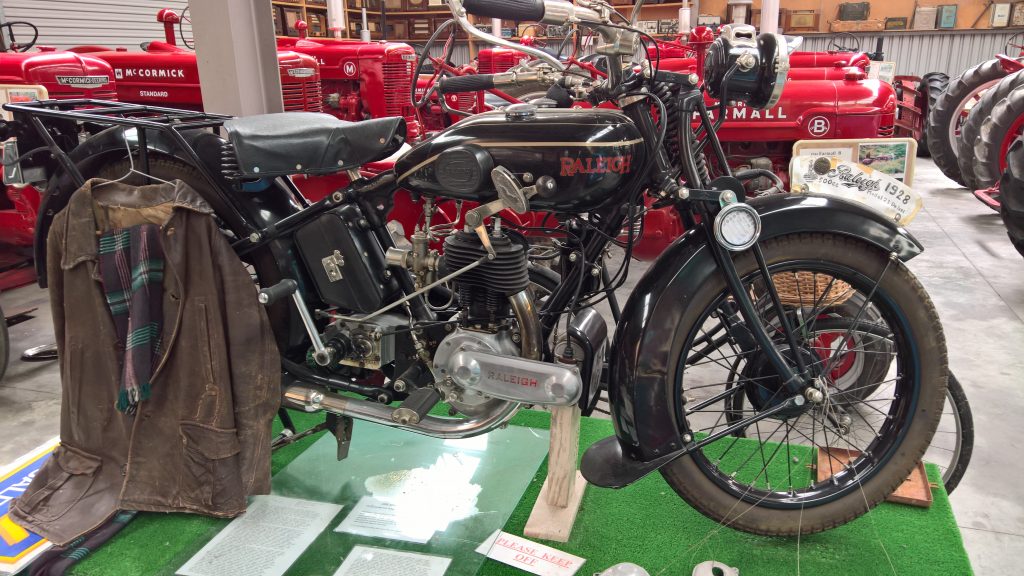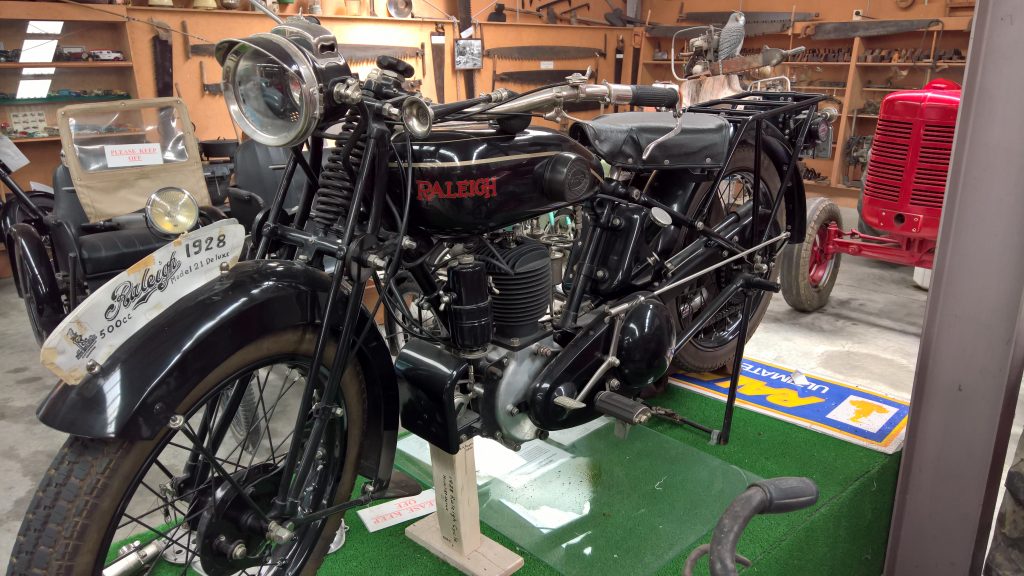I recently holidayed up at Cooper Beach ( Doubtless Bay, Northland) with Mrs K and Jr and one of the highlights of our trip was visiting Mathews Vintage Collection on SH10 just outside Taipa. Whilst admiring his fine and varied collection, I was taken with this magnificent Raleigh Model 21.
Along with the display was a typed letter from Bruce Auger explaining some of the background and challenges he had in restoring this motorcycle to this prodigious condition. I have transcribed his letter below , including typos, for all to enjoy.
There’s not much more I can add, I would have like to have seen this running and being ridden, even if it was just around the car park. Perhaps someone from the Far North VCC club could assist Winston in getting this running again and putting a video up on Winstons website, or YouTube for all to enjoy.
| Purdy St Kaikohe November 23, 1999 RALEIGH MOTOR CYCLE 1928 |
Engine No A 2162 |
| Dear Mick,
In 1964 I found this motor cycle on Mr Dors property at Puketi Forest in an open shed, and scattered about the farm in pieces. The engine was in a shed with gelignite dripping on to it from a shelf – on to the crankcase causing corrosion. |
|
| /2 ( page 2)
rebuild clutch parts by welding and repadding ( with brake lining) , cast brass brake pedal and machine and nickel. Make and cast carburettors, new housings and float bowls & tops, then turn up slides, jets, make floats and fittings, springs and petrol pipes and unions ( 3 complete carbs, 2 with needles, one with gauze, I think it had a needle type carb). Bruce Auger |
|
Sadly Bruce passed away in March 2013 but not before receiving his 50 Years award from the NZ Vintage Car Club. Following is a little history about Bruce and his exploits over the years. Thanks to Dave Duirs for providing this information and Winston Matthews for digging it out and sending it through.
|
BRUCE AUGER 50 YEARS NZVCC MEMBER As a perfectionist, Bruce Auger created an enduring legacy for Far North vintage motoring by way of his total dedication to restoration detail while enjoying tinkering with and driving older vehicles. Born in Greylyn in 1928 he and his family moved , via Maungatapere, to Ohaeawai in the Far North in 1934 where Bruce attended Kaikohe High school from 1943, showing an interest and aptitude in engineering and carpentry and, no doubt, old cars. Trained in the printing and engraving trade at the Kaikohe Northern News, many customers were European and one of his achievements was to engrave the Lord’s Prayer around the edge of a threepenny bit. As a film projectionist for nineteen years, he travelled over much of the Far North, as far as Waiharara. Bruce did a stint with the railways to get fresh air into his lungs, but the pay was not too good. In October 1962, after an initial meeting in Whangarei, the Northland Branch of the VCC of NZ was eventually established at Kaikohe to accommodate members north of Auckland and Bruce was amongst those present. Circumstances changed rapidly and it wasnt long before a Whangarei Branch was established and eventually the Northland Branch disbanded and joined Whangarei which ultimately became the Northland Vintage Car Branch. In 1976 it was the turn of northern members to form the The Far North Branch to cater for the likes of Bruce who had developed a strong interest in old cars. Initially he had a 1935 Austin 10 followed by an A30 and then an A50 and an early Triumph. Over the years a Vanguard and ’39 Chev were in his stable together with an association with sixteen motorbikes. He fitted independent electric brakes to the Vanguard, enabling the Vanguard to beat the faster Zephyrs on race track corners. Always ready for a challenge, Bruce was navigator in Vic McCready’s 1920 Minerva which represented the Northland VCC Branch in the 1965 International VCC rally in Christchurch. To add a bit of spice the guys drove from Cape Reinga to the Bluff and back at 22 miles per gallon, being the second car to cross the new Auckland harbour bridge. 1965 was the start of his affair with his uncle’s 1925 Buick McGlaughlin DX, the deal being that it should not be altered. This was difficult as the vehicle was set up as a truck which Bruce was keen to restore. The model, the only one to leave the factory as right hand drive, was brought to New Zealand by Lady McGlaughlin of Scotland after she had haggled with McGlaughlins, the Canadian car body builders. It languished in storage because it was not considered suitable by her friends, they being British and her car Canadian! Eventually someone from Dargaville purchased it but, after a pub visit he ran off the road and it required some patching up by the local blacksmith. It then became a Whangarei to Auckland taxi before Buce’s uncle acquired it, damaging the engine on the way home to Okaihau when he ran over some newly dumped road metal. A frame was attached and it was used to tow a saw mill before the body was removed, hung up in the rafters, and the chassis transformed into a traction unit with Bessemer diff and cast wheels all driven by two Dodge 4 engines in tandem. However, over twenty five years Bruce patiently gathered the body, which thankfully was still hanging in the shed in a reasonable state, and other parts including the original engine, 1925 pig skin for the upholstery and Canadian beech for the spokes to restore the car to its original glory. Mr McGlaughlin,at 92, visited and wanted to take it home, making Bruce a big offer which was refused. Four gallons of paint and twelve of thinners which came with the original car, were used to add the final touch to what is now a superb treasure, the only one of its era globally. Detail was the essence and as the vehicle had been registered as a Dodge because of the early engine change, a lengthy beaurocratic “battle” ensued to secure the rightful registration right down to the DB 1925 number plate which satisfied the official that it was Dodge Brothers but Bruce was happy that it signified the D(X)B(uick). The car was a star at the Buick 100 years celebrations in Napier. Bruce and Mollie still have the car and have arranged for its continuous use and safe keeping. Part way through this project the Buick work stalled as Bruce reckoned it would be cheaper to work on one of the motorbikes. About 1964, probably during one of his pig hunting exploits to the Puketi forest, Bruce found scattered about a shed what turned out to be the remains of a 1928 Raleigh 21 Deluxe motorcycle with many bits damaged or missing. Over the years he tracked down the original owner, sourced original paper work and embarked on a restoration to original specifications which involved hours of panel beating, casting and machining of petrol tanks, hubs and axles, mudguards, handle bars, lamps, timing case covers, “making” an Oldham oil pump, total cast and machine of the carburettor, bolts and nuts turned to specification the list goes on, to a total rebuild which would be a story on its own. The beautifully completed machine has been donated to the Matthews Vintage Collection where it is proudly and thankfully displayed together with one of his Miele bikes, a testimony to twenty five years of patience and dedication. He reckons that in hind sight, this project was probably dearer than the car refurbishment! Perhaps the real visual showpiece of this man’s skill is his restoration of vintage hubcaps, many of which were unrecognisable before he put his magic touch of detail on them. Frank Walker had quite a collection and did the paper work or research and Bruce and others contributed old hub caps which he duly beat, plated, polished and cut the polish to make them look old. The collection is now prominantly displayed on a board in the Far North Branch clubrooms, a reminder to members of the dedication and expertise that Bruce built into a hobby which has immortalised part of the country’s motoring history. Bruce, with Mollie who so often kept his dinner hot while he was in his shed, has contributed a great deal to the spirit of vintage motoring with his enthusiasm, skill and wealth of knowledge, all of which makes his Fifty Year membership badge a small but very deserving award. Dave Duirs July 2012 |


